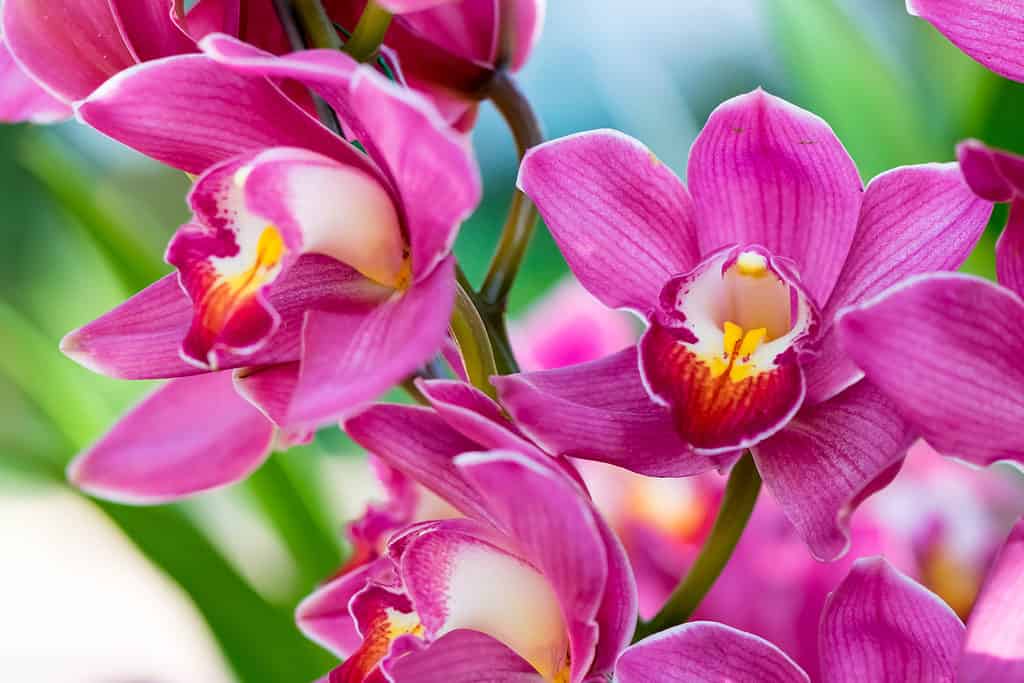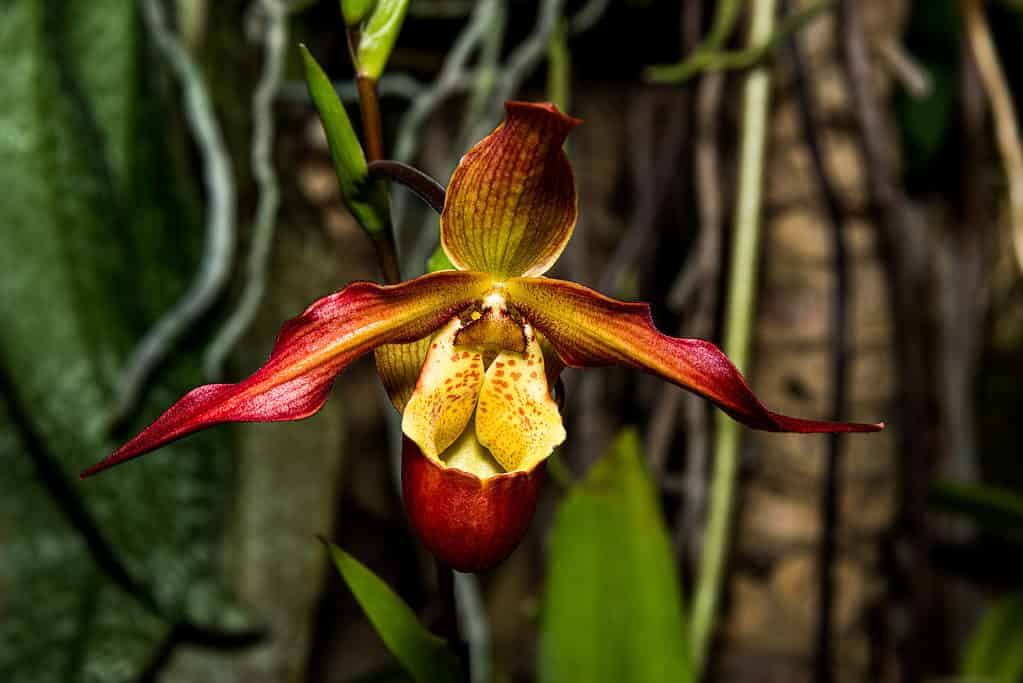If you want to try growing orchids, choosing the correct orchid soil or growing substrate for your plant is crucial. Some species thrive in soil, while others must grow in soil-less potting mixes or mounted to bark. To ensure the success of your orchid, you’ll need to understand its growing requirements fully.
In this guide, we’ll provide an overview of orchid classification and habitat diversity and then provide some examples of different soil and potting mix requirements for a couple of popular orchid genera.
So, without further ado, let’s jump right in!
Orchids: Botanical Classification and Habitat Diversity

Close-up of Thailand Cymbidium hybrid orchids.
©Sealstep/Shutterstock.com
To know what growing substrate to use for your orchid, it’s important to broadly understand orchids as a botanical family and what habitats they have evolved in. So, all 28,000 species of orchids belong to the Orchidaceae family. This family represents 10% of all flowering plant species and currently contains 880 genera.
When orchids first emerged on our planet almost 120 million years ago, they were all terrestrial plants. This means they grew and obtained their nutrients and water from the soil.
However, they didn’t just remain soil dwellers. A key driver in the current diversity of orchids occurred about 35 million years ago when most orchids became epiphytes. This change allowed them to attach themselves non-parasitically to the bark of trees. At this point, they began rapidly inhabiting a largely unfilled niche as epiphytes, and their species diversification skyrocketed.
Now, about 80% of all orchids are epiphytes, deriving their moisture intake from rainfall, mist, and dew, with much of this moisture filtered through moss and tree bark. As the water filters through these substrates, the roots can uptake both water and nutrients.
Some epiphytic orchids can also grow attached to rocks (lithophytic), obtaining nutrients that pass through moss and porous inorganic material.
Growing Orchids: Choosing the Right Soil or Growing Medium
So, the first piece of information you need to help you determine what kind of growing substrate to use is whether your orchid is epiphytic or terrestrial. For example, orchids in the widely popular Phalaenopsis genus (phals) are epiphytes. They won’t succeed in a soil-based potting mix and instead require a mix that mimics their natural growing environment. On the other end of the orchid spectrum, you have the also widely popular terrestrial-growing orchids in the Paphiopedilum genus (paphs). Species in this genus do thrive in soil-based mixes.
To continue with these two examples below, we’ll break down the general growing substrate guidelines for phals and paphs to highlight the differences in care for epiphytic versus terrestrial orchids. If you’re a beginner to growing orchids, this breakdown on soil and potting mixes should get you started in the right direction.
Epiphytic Orchid Growing Medium

Close-up of Schiller’s moth orchid,
Phalaenopsis schilleriana.
©PAUL ATKINSON/Shutterstock.com
As a general rule, epiphytic orchids, like those in the Phalaenopsis genus, require light, fast-draining, extremely well-aerated potting mixes. These orchids need to be mounted onto bark and partially covered in moss. If potted, the best choice is usually to use clay pots since they wick away excess moisture. Another excellent option is to plant your epiphytes in open-slotted wooden hanging baskets, allowing the roots to expand through the slots and access plenty of airflow.
Options for Potting Mixes
Potting mixes for epiphytic orchids are normally chopped bark or tree fern fiber-based. The coarseness of the medium depends upon the species. For phals, medium-sized chopped fir bark, perlite, and sphagnum moss make an excellent mixture that suits this orchid genus’s drainage and moisture retention needs.
The bark keeps the potting mix light and non-compacted, allowing plenty of air to circulate around the plant’s roots. Other common barks used in epiphytic orchid potting mixes include Monterey, coastal redwood, and tree fern fiber. The coarser-sized the bark, the less compact the potting mix, increasing drainage speed. Depending on the species, you may need a smaller-grained bark size to allow water to drain a bit slower.
Sphagnum or peat moss is excellent at retaining moisture while allowing air to circulate. This moisture retention from the moss allows the growing medium to stay moist, but the aeration of the moss, bark and other amendments ensures the substrate does not become soggy. A study by Texas A&M University demonstrated that orchids grown in 80% fir bark and 20% sphagnum moss produced far better growth than orchids grown in fir bark alone.
All orchids, and especially epiphytic orchids, do not tolerate soggy roots. Perlite, and other amendments like charcoal, coconut husks, diatomite, and lava rock, provide additional structure to the substrate, aiding in aeration and drainage.
Terrestrial Orchid Growing Medium

Close-up of Chinese New Year’s orchid (
Cymbidium sinense).
©gmeland/Shutterstock.com
While terrestrial orchids can handle more water retention than their tree-clinging relatives, they still need well-draining soil with excellent aeration to thrive. Like epiphytes, terrestrial orchids don’t tolerate soggy roots and are prone to develop root rot if left in standing water.
Soil-dwelling orchids like those in the Paphiopedilum genus tend to thrive in loamy soils that drain well and are rich in humus. You’ll want to create excellent soil structure, aeration, and drainage when potting terrestrial orchids.
A popular potting mix that works well for terrestrial orchids like paphs comprises loamy soil, sphagnum moss, and fine-grained fir bark. Some growers like adding 1/8th of compost or manure to their terrestrial mixes.
Using loamy soil rather than clay as your base ensures the potting mix will be light, non-compacted, and faster draining. Since terrestrial orchids tend to like more water retention than epiphytes, using a fine-grained fir bark helps prevent the potting structure from being too loose and airy. As with the epiphytic orchid mixes, the chopped sphagnum moss helps with moisture retention and aids in keeping air circulating around the roots.
The photo featured at the top of this post is © Arielvelasquez0896/Shutterstock.com
Thank you for reading! Have some feedback for us? Contact the AZ Animals editorial team.






